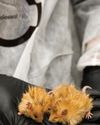Denemek ALTIN - Özgür
The Real-Life: BATMAN
Muse Science Magazine for Kids
|January 2021
HOW ONE PERSON SEES THROUGH SOUND

Using a wall for balance, Daniel Kish steadied himself on his new bike. He peddled ahead, wobbling a little. Soon the 6-year-old was pushing away from the wall and picking up speed, riding all on his own. This story isn’t a big deal until you learn one important detail: Kish was blind.
Kish, who is now an adult, lost his eyes to retinal cancer as a baby. But he doesn’t let the lack of sight slow him down at all. He uses something he calls “flash sonar” to help him navigate the world. He makes clicks with his tongue and listens to how the sound bounces offthe things around him. His brain uses this information to create an image of the world around him. This technique is similar to what dolphins and bats do to locate and navigate their surroundings: they cry or chirp and listen for the echo. Kish is a real-life bat man.
LIGHT AND SOUND
Kish relies on sound and echoes instead of light to perceive his surroundings. This process is called echolocation.
Light energy travels in waves that go up and down, like waves on the ocean. These waves hit objects, whether a shirt, a mirror, or your face, and much of that light is reflected off. When you look at an object, what you see is the reflection of light from that object. Your brain translates that reflection into an image. This is how sighted people perceive and make sense of the world. Without light and the reflections of light, eyes can’t see anything.

Bu hikaye Muse Science Magazine for Kids dergisinin January 2021 baskısından alınmıştır.
Binlerce özenle seçilmiş premium hikayeye ve 9.000'den fazla dergi ve gazeteye erişmek için Magzter GOLD'a abone olun.
Zaten abone misiniz? Oturum aç
Muse Science Magazine for Kids'den DAHA FAZLA HİKAYE

Muse Science Magazine for Kids
ANIMAL FIREFIGHTER TO THE RESCUE
Can animals help manage the risks of deadly wildfires?
3 mins
Muse July 2025: The Story Behind Wildfires

Muse Science Magazine for Kids
FIRE DANGER
WHY THE RISK OF WILDFIRES KEEPS GROWING
4 mins
Muse July 2025: The Story Behind Wildfires

Muse Science Magazine for Kids
The Miller NEW Normal
WHAT TODAY’S WILDFIRES TELL US ABOUT OUR FUTURE
8 mins
Muse July 2025: The Story Behind Wildfires

Muse Science Magazine for Kids
WOMEN AND FIREFIGHTING: A GOOD FIT
Jessica Gardetto is a firefighter. Her father was, too. “I grew up with my dad coming home smelling like wildfire and covered in soot,” she says.
1 min
Muse July 2025: The Story Behind Wildfires

Muse Science Magazine for Kids
What is happening on your fingertips when they get all wrinkly in a hot tub?
—Felix G., age 10, Montana
1 mins
Muse July 2025: The Story Behind Wildfires

Muse Science Magazine for Kids
WHEN the SMOKE CLEARS
THE LINGERING EFFECTS OF THE RECENT PACIFIC PALISADES AND ALTADENA EATON FIRES
6 mins
Muse July 2025: The Story Behind Wildfires

Muse Science Magazine for Kids
PICKING TEAMS
Keep it fair with a strategy that relies on geometry.
2 mins
Muse July 2025: The Story Behind Wildfires

Muse Science Magazine for Kids
SHAN CAMMACK
WILDLIFE BIOLOGIST AND FIRE SAFETY OFFICER
3 mins
Muse July 2025: The Story Behind Wildfires

Muse Science Magazine for Kids
Scientists Create Mice With Woolly Mammoth-Like Fur
RESEARCHERS AT A COMPANY IN TEXAS ARE WORKING TO CREATE A LIVING ANIMAL THAT RESEMBLES THE EXTINCT WOOLLY MAMMOTH. Recently, they produced mice with traits of the large mammal. The mice all have coats with mammoth-like fur, and some of the small mammals also have genes that help them store fat. Both features would help the animals survive in the cold Arctic, where the woolly mammoth once lived.
1 min
Muse July 2025: The Story Behind Wildfires

Muse Science Magazine for Kids
Cool Sunshade Added to the Nancy Roman Space Telescope
THE NANCY ROMAN SPACE TELESCOPE IS A NEW TELESCOPE THAT NASA IS BUILDING AND WILL LAUNCH INTO SPACE, LIKELY IN EARLY 2027.
1 min
Muse July 2025: The Story Behind Wildfires
Translate
Change font size

